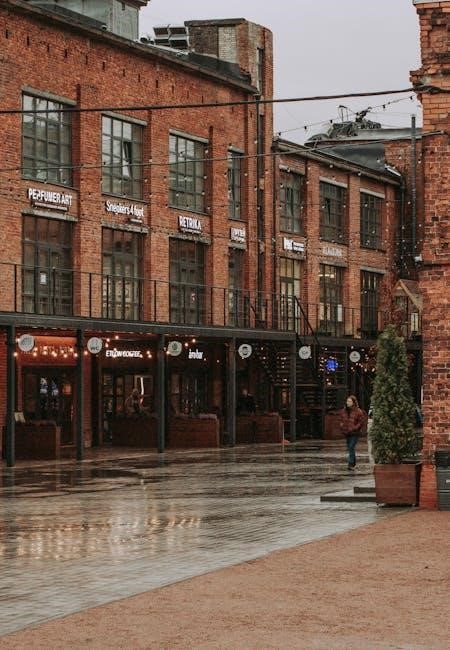Perfumery is the ancient art and science of fragrance creation‚ tracing back to Mesopotamia in 1200 BC. It involves blending natural and synthetic ingredients to craft unique scents‚ essential for beauty‚ health‚ and cultural expression‚ as detailed in historical and modern perfumery guides.
Definition and Scope of Perfumery
Perfumery is the art and science of creating fragrances by blending essential oils‚ aroma compounds‚ and other ingredients. It encompasses the creation of scents for personal‚ household‚ and industrial use‚ combining natural and synthetic materials. Perfumery’s scope extends beyond cosmetics‚ into agriculture‚ therapy‚ and cultural practices‚ making it a versatile and enduring craft with applications across diverse industries and traditions‚ as outlined in comprehensive perfumery guides.
Historical Background of Perfumery
Perfumery traces its origins to ancient Mesopotamia around 1200 BC‚ where Babylonians developed scent extraction methods. Egyptians later refined these techniques‚ using fragrances in rituals and burials. The art evolved through the Greeks and Romans‚ who popularized perfumes for personal use. Historical texts‚ like those from al-Kindi and Parry‚ document early practices‚ while modern guides reveal its global evolution‚ blending tradition with innovation in fragrance creation and cultural expression.
Modern Applications of Perfumery
Modern perfumery extends beyond cosmetics‚ influencing industries like agriculture and healthcare. Fragrances enhance emotional well-being‚ while perfumed insecticides aid pest control. Sustainable practices now prioritize ethical sourcing and eco-friendly production. Advances in synthetic ingredients and digital fragrance design tools are revolutionizing the field‚ ensuring perfumery remains a vital and evolving art‚ addressing diverse needs across cultures and industries while maintaining its luxurious appeal and practical applications.
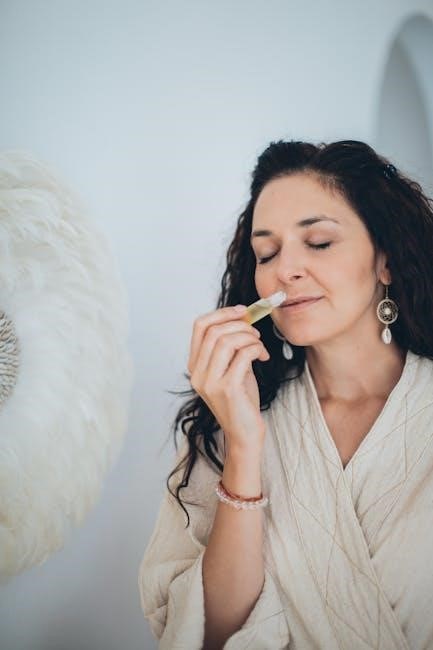
The Science Behind Perfumery
The science of perfumery involves understanding the molecular structure of odorants‚ essential oils‚ and aromatic chemicals. It explores how these ingredients interact to create complex fragrance compositions and their sensory effects.
Odorants and Their Molecular Structure
Odorants are organic molecules with a molecular mass between 18-300 Daltons‚ typically containing a single polar group. These compounds‚ like linalool and terpenes‚ are crucial in perfumery‚ contributing to distinct scents. Their structure determines volatility and perception‚ with lighter molecules evoking top notes and heavier ones base notes‚ creating complex fragrance profiles essential for perfumes and cosmetics‚ as detailed in scientific studies and perfumery guides.
The Role of Essential Oils and Aromatic Chemicals
Essential oils‚ such as bergamot and lavender‚ are extracted from plants and form the heart of perfumery. Aromatic chemicals‚ including terpenes and esters‚ enhance scents and stability. These ingredients are blended to create fragrance accords‚ offering depth and complexity to perfumes‚ as outlined in perfumery guides and historical texts‚ ensuring their enduring significance in the craft.
Understanding Fragrance Families
Fragrance families‚ such as Floral‚ Oriental‚ and Citrus‚ classify scents by their dominant notes. These categories help perfumers create harmonious blends and guide consumers in selecting fragrances. Each family has distinct characteristics‚ like the sweetness of Florals or the spice of Orientals‚ shaping the emotional and sensory impact of perfumes‚ as detailed in perfumery guides and historical fragrance manuals.
Materials Used in Perfumery
Perfumery utilizes a blend of natural ingredients‚ such as essential oils and absolutes‚ and synthetic components to craft unique fragrances‚ each contributing distinct qualities to the final scent.
Natural Ingredients: Essential Oils and Absolutes
Natural ingredients form the cornerstone of perfumery‚ with essential oils extracted from plants like Salvia officinalis and Coriandrum sativum. These oils‚ often obtained through traditional or supercritical fluid extraction‚ provide unique fragrance profiles. Absolutes‚ derived from delicate flowers‚ are used to create rich‚ complex scents. Both are prized for their authenticity and depth‚ making them indispensable in crafting distinctive perfumes‚ as highlighted in comprehensive perfumery guides and historical texts.
Synthetic Ingredients and Their Importance
Synthetic ingredients are crucial in modern perfumery‚ offering versatility and consistency. They complement natural elements by providing unique‚ stable‚ and cost-effective solutions. Molecules like linalool and its esters are widely used for their light‚ pleasant notes. Synthetics enable the creation of complex fragrances that natural ingredients alone cannot achieve‚ ensuring durability and uniformity in perfumes‚ as detailed in advanced perfumery guides and scientific studies.
The Use of Accords in Perfume Creation
Fragrance accords are sophisticated blends of ingredients that create harmonious‚ complex scents. By combining natural and synthetic elements‚ accords evoke emotions and concepts‚ adding depth and originality to perfumes. They are essential for crafting distinctive fragrances‚ as they balance contrasting notes and enhance olfactive depth‚ making them a cornerstone in modern perfumery‚ as explored in detailed perfumery guides and technical manuals.
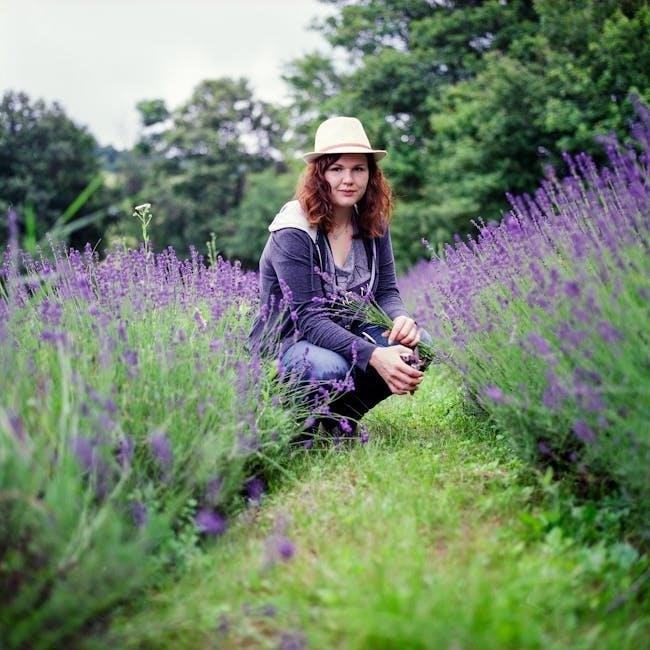
The Perfume Creation Process
Perfume creation involves conceptualization‚ blending‚ and refinement. It starts with designing fragrances‚ followed by precise blending techniques‚ and concludes with rigorous quality control and sensory testing to ensure excellence.
Conceptualization and Design of Fragrances
The conceptualization of fragrances begins with inspiration‚ translating ideas into scent. Perfumers explore themes‚ emotions‚ or cultural elements to craft unique fragrance designs. This phase involves selecting raw materials‚ balancing notes‚ and ensuring harmony. Skilled artisans use their olfactive skills to experiment and refine blends‚ transforming abstract concepts into tangible fragrances that evoke desired emotions and experiences‚ as outlined in detailed perfumery guides.
Blending Techniques and Formulas
Perfumery relies on precise blending techniques to combine essential oils‚ synthetics‚ and accords. These formulas are crafted to balance top‚ middle‚ and base notes‚ ensuring a harmonious scent evolution. Skilled perfumers use weighted formulas to allocate percentages for each ingredient‚ creating unique fragrances. This process requires expertise in olfactive evaluation and chemical compatibility‚ as detailed in perfumery guides and practical handbooks for fragrance creation.
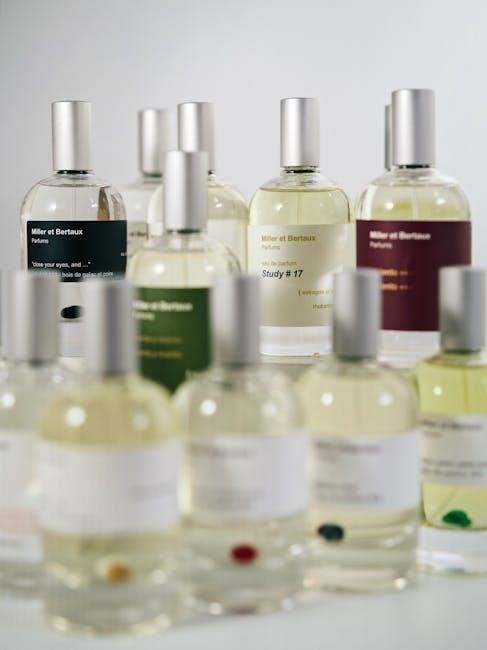
Quality Control and Testing
Quality control in perfumery ensures fragrance consistency and safety. Perfumes undergo rigorous testing‚ including scent longevity‚ stability‚ and skin safety evaluations. Gas chromatography and sensory panels assess the fragrance’s olfactive profile. Adherence to international standards guarantees consumer safety. This process is detailed in perfumery guides‚ emphasizing the importance of precision and expertise in maintaining high-quality fragrances.
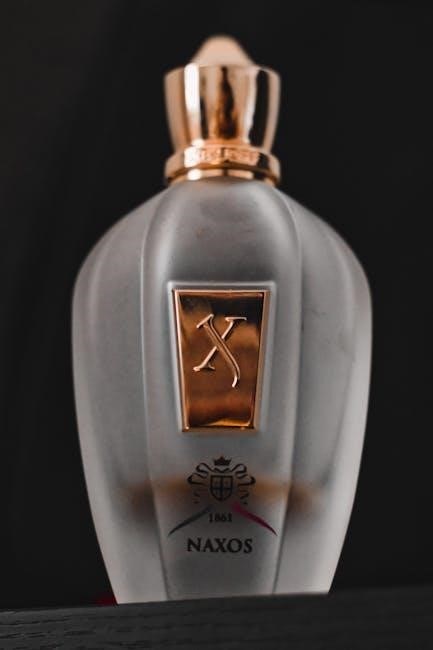
Fragrance Classification
Fragrance classification organizes scents into families like Floral‚ Oriental‚ and Citrus‚ helping to understand and categorize perfumes based on their dominant notes and olfactive characteristics‚ as detailed in perfumery guides.
Top‚ Middle‚ and Base Notes
The top notes are the initial scents perceived‚ typically light and fleeting‚ evaporating quickly to introduce the fragrance. They are composed of small‚ volatile molecules that create the first impression. The middle notes‚ or heart of the fragrance‚ emerge after the top notes fade‚ providing depth and complexity. These are often floral‚ spicy‚ or fruity‚ lasting several hours. Finally‚ the base notes are rich‚ deep‚ and long-lasting‚ anchoring the fragrance with woody‚ musky‚ or amber tones that linger on the skin;
Fragrance Families: Floral‚ Oriental‚ Citrus‚ etc.
Fragrance families categorize scents into distinct groups. Floral fragrances highlight flower notes like rose and jasmine‚ evoking classic elegance. Oriental scents blend amber‚ musk‚ and spices for warmth and depth. Citrus fragrances are fresh and vibrant‚ featuring lemon and bergamot. Woody notes‚ with cedar and sandalwood‚ evoke earthy sophistication‚ while Fresh fragrances use aquatic and green elements for modern appeal. These families guide perfumers in creating diverse and nuanced scents.
Classification Systems in Perfumery
Perfumery uses classification systems to organize fragrances‚ aiding creators and consumers. The Fragrance Wheel‚ developed by Michael Edwards‚ categorizes scents into families like Floral‚ Oriental‚ Citrus‚ and Woody. These systems simplify fragrance identification and creation‚ providing a structured framework for understanding scent profiles and their combinations‚ essential for both artistic and commercial perfumery practices.
Perfumery in Different Cultures
Perfumery holds cultural significance worldwide‚ with ancient practices in Mesopotamia‚ Egypt‚ and China. It is integral to rituals‚ spiritual practices‚ and aesthetic traditions‚ reflecting diverse cultural identities globally.
Ancient Civilizations and Their Perfumery Practices
Ancient Mesopotamia‚ Egypt‚ and China pioneered perfumery‚ using aromatic substances for religious rituals‚ burials‚ and royal courts. Egyptians employed myrrh and frankincense‚ while Chinese utilized cinnamon and sandalwood. These civilizations developed primitive distillation methods‚ laying the groundwork for modern perfumery. Their practices emphasized scent’s spiritual and cultural significance‚ reflecting the deep-rooted connection between fragrance and human history across diverse regions and traditions.
Perfumery in Traditional and Modern Culture
Perfumery holds significant cultural value‚ from ancient rituals to modern luxury. Traditionally‚ fragrances were used in religious ceremonies‚ royal courts‚ and as status symbols. Today‚ perfumery is a global industry‚ blending tradition with innovation. Modern culture embraces diverse fragrance styles‚ from niche artisanal scents to mass-market perfumes‚ reflecting personal identity and lifestyle. Sustainability and ethical practices are increasingly shaping the industry‚ preserving its artistic heritage while adapting to contemporary demands and environmental consciousness.
Cultural Significance of Fragrances
Fragrances hold profound cultural and emotional significance‚ often symbolizing identity‚ spirituality‚ and tradition. Across civilizations‚ scents have been used in rituals‚ ceremonies‚ and social hierarchies‚ reflecting cultural values. From ancient Mesopotamia to modern times‚ perfumes have served as status symbols and emotional connectors. Traditional practices‚ such as scent blending for religious rites‚ continue to inspire contemporary perfumery‚ bridging heritage with modern identity and personal expression.
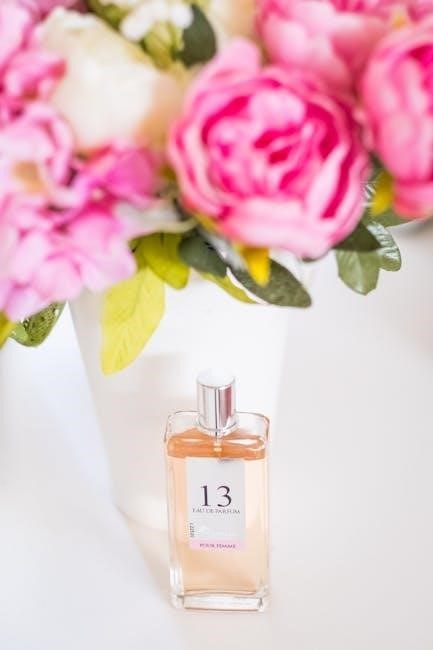
Perfume Packaging and Presentation
Perfume packaging reflects historical and modern trends‚ with intricate designs and materials. Elegant bottles‚ labels‚ and brand imagery convey luxury and identity‚ enhancing sensory appeal and market presence.
Historical and Modern Packaging Trends
Perfume packaging has evolved from ancient glass vessels to modern eco-friendly designs. Historically‚ ornate bottles with intricate craftsmanship were common‚ while today‚ sustainability drives trends‚ with recyclable materials and minimalist aesthetics gaining prominence. The mid-20th century saw the rise of aerosol sprays‚ revolutionizing application methods. Modern packaging often combines functionality with artistic expression‚ reflecting brand identity and consumer preferences‚ while maintaining the luxury and allure associated with fine fragrances.
The Role of Bottles‚ Labels‚ and Design
Bottles‚ labels‚ and design are critical elements in perfume presentation‚ serving as visual ambassadors for fragrance brands. Elegant bottle shapes and materials convey luxury‚ while labels provide essential information and aesthetic appeal. Design elements like color schemes and typography enhance brand identity‚ distinguishing products in a competitive market. These components collectively create an emotional connection with consumers‚ influencing perceived value and purchase decisions‚ as highlighted in perfumery guides.
Brand Identity Through Packaging
Packaging plays a pivotal role in establishing and reinforcing a perfume brand’s identity. Through distinctive bottle designs‚ label artwork‚ and overall aesthetic‚ packaging communicates the brand’s values and appeal. Consistent design elements create recognition and loyalty‚ while unique packaging can differentiate a brand in the market. This visual storytelling enhances emotional engagement and brand memory‚ ensuring the perfume stands out and resonates with its target audience effectively.
Perfumery in Agriculture and Beyond
Perfumery extends beyond cosmetics‚ with fragrances used in agriculture to repel pests and attract pollinators. Aromatic plants like coriander and sage bridge perfumery and farming‚ enhancing sustainability and yield.
Perfume in Agriculture: Uses and Benefits
Perfumery plays a vital role in agriculture through the use of aromatic plants and essential oils. Fragrances like linalool‚ found in bergamot and lavender‚ repel pests and attract pollinators‚ enhancing crop yield. Plants such as coriander and sage are cultivated for their volatile oils‚ which not only benefit perfumery but also serve as natural insecticides and growth enhancers‚ promoting sustainable farming practices and improving agricultural productivity.
Perfumed Insecticides and Their Applications
Perfumed insecticides leverage fragrant compounds like linalool‚ found in bergamot and lavender‚ to repel pests naturally. These scents‚ often used in perfumery‚ are integrated into agricultural practices to protect crops. Coriander and Salvia officinalis‚ rich in volatile oils‚ serve as eco-friendly alternatives to synthetic pesticides‚ enhancing sustainability and reducing environmental harm while maintaining efficacy in pest control and crop protection.
Miscellaneous Uses of Perfumery
Perfumery extends beyond fragrance; it plays roles in potpourri creations‚ Traditional rituals‚ and therapeutic practices. Essential oils like lavender and bergamot are used in aromatherapy for relaxation. Perfumed products also enhance household items‚ such as scented candles and room sprays‚ while cultural practices incorporate fragrances for spiritual and symbolic purposes‚ showcasing perfumery’s diverse applications beyond personal use.
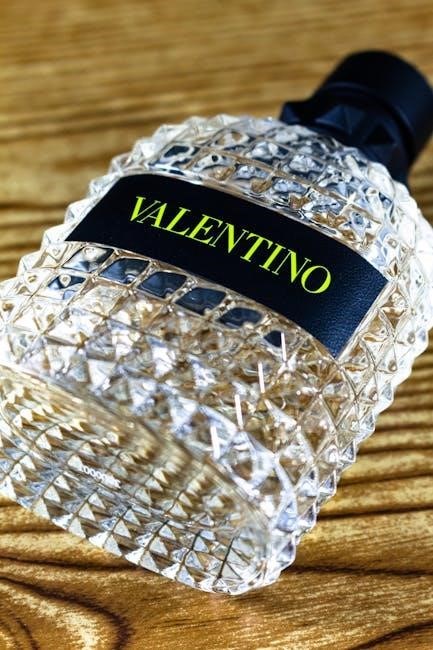
Training and Education in Perfumery
Advanced perfumery programs offer in-depth training‚ focusing on olfactive skills and fragrance creation. Workshops and courses are available for professionals‚ while universities and research institutions provide structured education in this field.
Advanced Perfumery Programs
Advanced perfumery programs provide in-depth training‚ focusing on olfactive skills and fragrance creation. These programs cater to professionals in creation houses‚ brands‚ and distribution‚ aiming to enhance their expertise. Courses often include practical workshops‚ exploring complex fragrance design and the science behind scent composition. Participants gain insights into market trends and the use of natural and synthetic ingredients‚ ensuring a comprehensive understanding of modern perfumery practices.
Workshops and Courses for Professionals
Workshops and courses for professionals in perfumery offer hands-on training‚ focusing on advanced fragrance formulation and industry trends. These programs often collaborate with universities and experts‚ providing practical insights into scent creation. Staff training‚ such as at TCFF in Thailand‚ emphasizes theoretical and scientific knowledge‚ ensuring professionals stay updated on modern techniques and materials‚ bridging academia and industry practices effectively.
The Role of Universities and Research Institutions
Universities and research institutions play a pivotal role in advancing perfumery education through specialized programs and collaborations. They train future professionals‚ conduct research on fragrance chemistry‚ and explore sustainable practices. Institutions like those in Thailand partner with industry experts‚ fostering innovation and providing resources for professionals to refine their skills and stay updated on emerging trends in the field of perfumery.
Sustainability in Perfumery
Sustainability in perfumery prioritizes ethical sourcing of raw materials‚ reducing environmental impact through eco-friendly practices‚ and embracing future trends like biodegradable packaging and natural ingredients.
Ethical Sourcing of Raw Materials
Ethical sourcing in perfumery involves ensuring that raw materials are obtained responsibly‚ with fair labor practices and minimal environmental harm. This includes sustainable harvesting of plants like bergamot and lavender‚ and traceable supply chains for synthetic ingredients. Transparency in sourcing is crucial to maintain trust and integrity in the industry‚ as highlighted in perfumery guides and sustainability reports; Eco-friendly practices and certifications are increasingly prioritized to protect both people and the planet.
Environmental Impact of Perfume Production
Perfume production can have significant environmental effects‚ including resource depletion and chemical pollution. Essential oils require large quantities of raw materials‚ while synthetic ingredients may harm ecosystems if improperly disposed of. Energy-intensive manufacturing processes and packaging further contribute to carbon emissions. Addressing these issues is crucial for sustainable practices‚ as outlined in perfumery guides and industry reports focusing on eco-friendly alternatives and waste reduction strategies.
Future Trends in Sustainable Perfumery
Sustainable perfumery is evolving through eco-conscious practices‚ such as using biodegradable materials and ethical sourcing. Innovations in green chemistry and renewable energy are reducing environmental impact. Plant-based alternatives and refillable packaging are gaining popularity‚ aligning with consumer demand for eco-friendly products. These advancements ensure the industry remains both artistic and environmentally responsible‚ as highlighted in recent perfumery guides and market analyses.
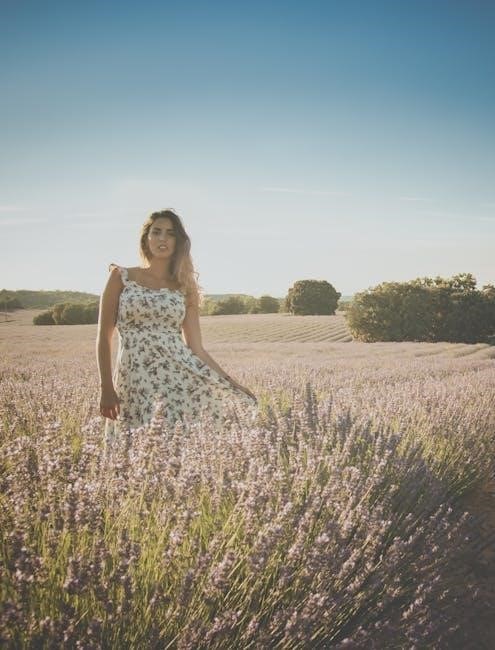
Famous Perfumes and Their Stories
Iconic fragrances like Chanel No. 5 and Shalimar have shaped perfumery history‚ blending innovation with timeless allure. These legends reflect the artistry of master perfumers‚ as detailed in perfumery guides.
Iconic Perfumes in History
Perfumes like Chanel No. 5 and Shalimar are timeless classics‚ revolutionizing the industry. Created in the 1920s and 1930s‚ they blended innovative ingredients and techniques‚ setting new standards. These fragrances‚ detailed in historical perfumery guides‚ remain symbols of luxury and artistry‚ inspiring modern perfumery while preserving their historical charm and cultural significance.
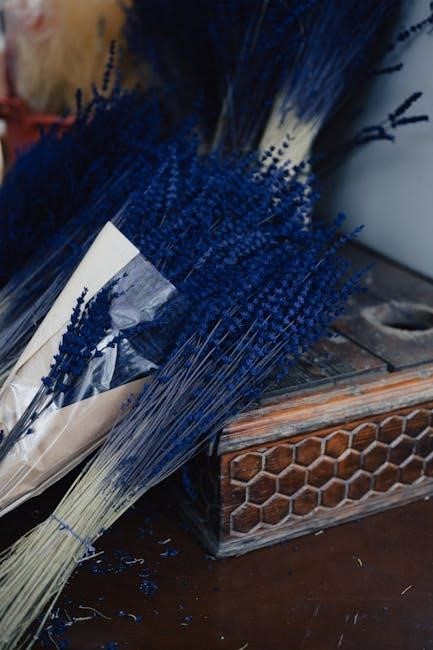
The Artisans Behind Legendary Fragrances
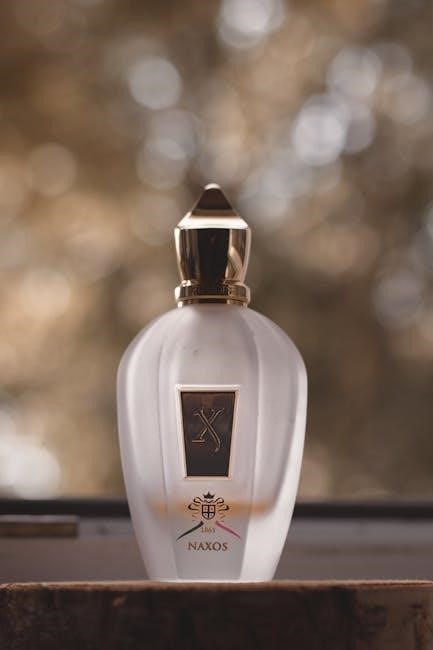
Master perfumers like Coco Chanel and Guerlain have shaped the industry with their iconic creations. Their expertise in blending natural and synthetic ingredients has crafted timeless scents. These artisans‚ celebrated in perfumery guides‚ bring artistic vision and technical skill to fragrance design‚ leaving a lasting legacy in the world of perfumery.
The Evolution of Perfume Design
Perfume design has evolved from ancient scent rituals to modern‚ sophisticated fragrances. Early civilizations used rudimentary extraction methods‚ while Renaissance perfumers refined techniques. The 20th century introduced synthetic ingredients‚ expanding creative possibilities. Today‚ perfumery blends artistry with science‚ emphasizing sustainability. Master perfumers craft iconic scents‚ reflecting cultural trends and technological advancements‚ as detailed in comprehensive perfumery guides and historical texts.
